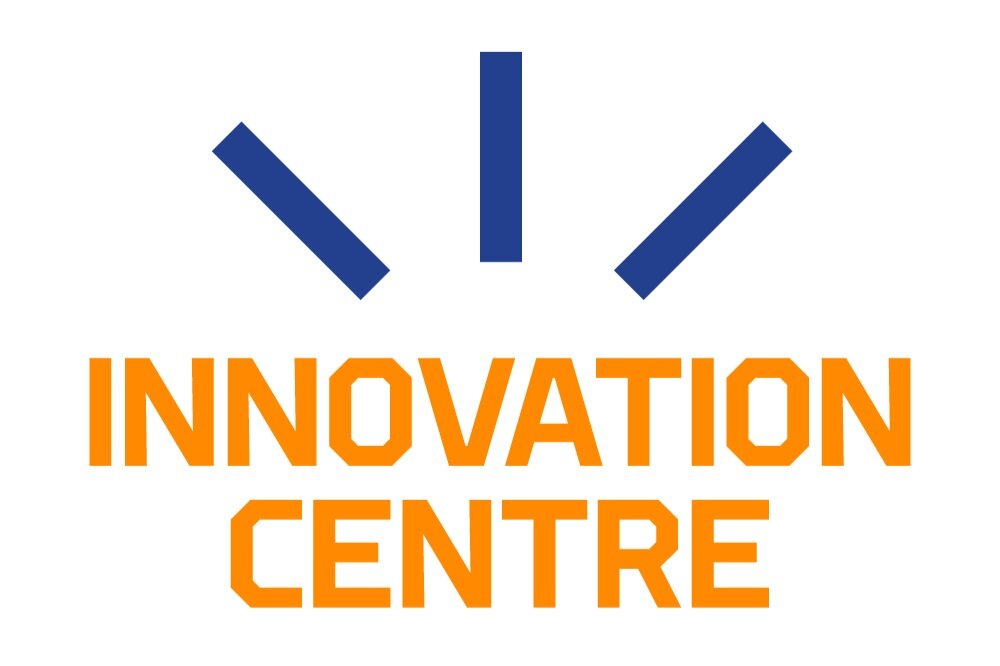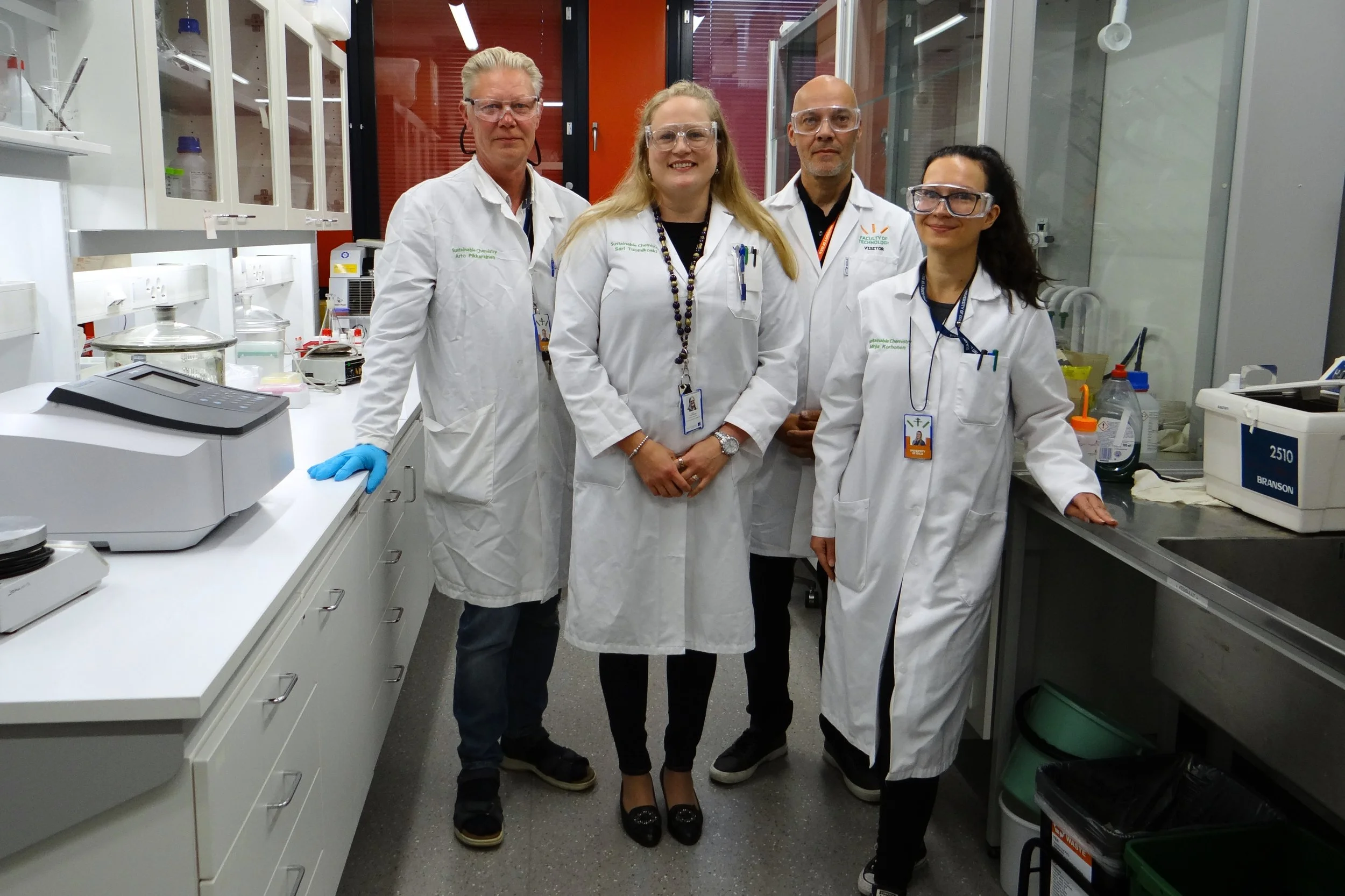CAAMA is a cheaper and more environmentally friendly option for water purification
Kirjoittanut Vilma Lehto
In the photo (left): Arto Pikkarainen, Sari Tuomikoski, Petri Aikio, who is part of the commercialisation team, and Minja Korhonen.
One of the projects underway at the University of Oulu is CAAMA, which stands for column-casted alkali-activated material adsorbent. The project’s goal is to introduce new alternatives for industrial wastewater treatment. Developed by the Research Unit in Sustainable Chemistry, the project offers a cheaper, more efficient, sustainable and environmentally friendly solution for water purification than those currently available on the market.
The CAAMA process includes the preparation, use, washing and regeneration (i.e. recycling back into the process) of the water purification material. The idea originated in the research of doctoral researcher Arto Pikkarainen. Before initiating his research work, Pikkarainen discussed the topic of his doctoral thesis with Ulla Lassi, Head of the Research Unit in Sustainable Chemistry.
“Ulla suggested that I develop an environmentally friendly adsorbent material for water purification, because she knew my background. I have 25 years of experience in water purification from various fields and industries. I gathered all my expertise into a doctoral thesis and this specific product. You could actually call it my lifework,” says Pikkarainen.
The product that Pikkarainen is referring to is an adsorbent, that is, a material that collects metals from industrial waters. He has not developed the material alone, as the Research Unit in Sustainable Chemistry has been conducting related research for a long time. The plan is now to commercialise the product, aided by the Research to Business funding granted to the project by Business Finland. In addition to researchers, the project involves a commercialisation team of three people.
Up to 100 per cent of metals recovered
The adsorbent developed by Pikkarainen is made from kaolin clay using chemicals that are harmless to the environment. In other words, they are non-toxic and natural. The adsorbent is poured directly into the columns, that is, the vertical pipes through which the water to be cleaned passes.
“Imagine you have a surface with small indentations. You also have balls, which in this case are the metals in the water. When you pour water containing metals through the column, the surfaces are filled with these balls. The column is then regenerated by vacuuming the balls, so to speak. In this way, the column can be reused for water purification,” says Minja Korhonen, a doctoral researcher participating in the project.
To date, the research team has successfully optimised the treatment of wastewater from two different mines under laboratory conditions. This is no easy task, as every sample of water is always different. Using experimental methods, the team must now find the best possible conditions to ensure that the adsorbent captures metals as efficiently as possible from each water sample.
“Next, we’ll begin testing the product on a larger scale in industry. A pilot project will be built in a sea container, and we expect it to be completed by the end of the year,” says Pikkarainen.
Pipelines containing the adsorbent will be placed inside the container. The water will flow through the pipelines because the material is so porous. After this, the metals will be washed off the material with a washing chemical, which has also been developed by the research team.
Text continues after the photo.
Graphical presentation of the pilot.
“Depending on the water and the metals in it, we can recover on average 95 to 100 per cent of the metals,” says Pikkarainen.
Will the water that has undergone the process actually be suitable for drinking?
“That’s a good question. How clean is clean enough? However, the standards for water used in the mining industry and drinking water are so different that the two cannot be directly compared. Fortunately, Finland is not in a situation where water from the mining process needs to be directed into the tap,” says Sari Tuomikoski, who works as a university researcher in the Research Unit in Sustainable Chemistry and as project manager in CAAMA.
A much more environmentally friendly and efficient process
Using the CAAMA process for water purification offers a number of advantages: compared to current water purification processes, the method is less expensive and has low operating costs as well as a minimal environmental impact. In addition, the developed material is up to 20 times more effective than the commonly used activated carbon adsorbent. It also collects metals for recycling.
“We are beginning to run out of earth metals, and this process enables us to recycle them as much as possible. We have recovered nickel and copper, for example, from the mining waters whose purification we have already optimised.”
Moreover, the production process of the adsorbent itself is significantly more environmentally friendly than that of adsorbents previously used in water purification. In the production of the latter, temperatures may rise up to thousands of degrees, but this adsorbent can be made in temperatures of 60 or 70 degrees. The materials used are environmentally friendly in other respects as well and do not burden the environment.
The next step is to carry out a pilot project to test how the product works in mines. If all goes well, the product can be commercialised. Currently, the process focuses on the treatment of wastewater from mines, but some day it can also be used in other industries, such as the battery, steel, pulp, paper and textile industries.
“The mining industry is currently under pressure from a sustainability perspective and therefore has to seek new innovative wastewater treatment methods. Our product and process thus have great potential,” says Pikkarainen.
Vilma Lehto
Viestinnän harjoittelija / Communications Intern
+358 50 305 5761
vilma.lehto@oulu.fi
Blogitekstit, uutiset, sosiaalinen media, tapahtumaviestintä.
Blog posts, news, social media, events communication.




